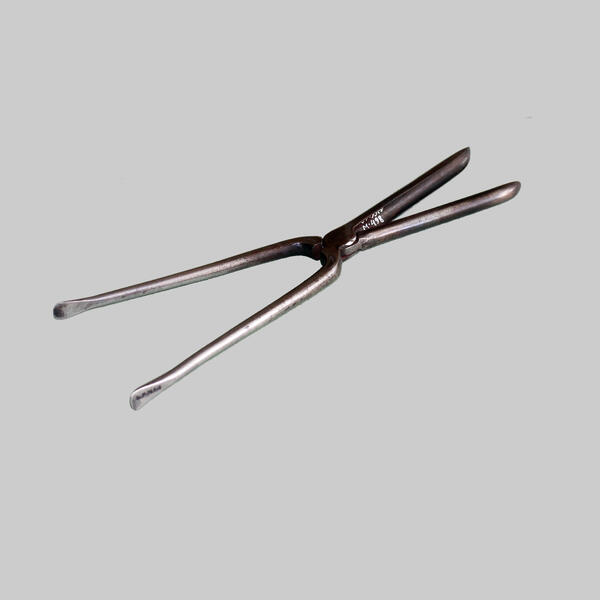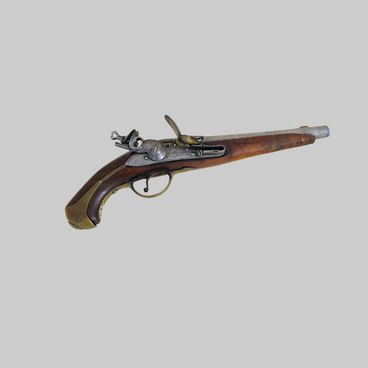The hair curling iron presented in the Decembrists in Yalutorovsk exhibit was donated to the museum by the Russian Cultural Foundation.
The iron was designed with a scissor-like look, straight rod handles and flat ends. The working part is made up of a grooved plate and a rod with a sharp end. Marcel Grato is considered to be the inventor of this device. His invention was born in 1880. Marcel Grato connected two iron rods, very similar to the way scissors are made. The mechanism was very simple. They were heated over the fire, and then used to press locks of hair in between their rods. Marcel Grato used the iron in a special way; if you clamp a strand of hair with the tongs with a notch down, you get an inward curve, and if up, then an outward one. Hair curled with this method resembled a series of waves. In 1882 Marcel Grato opened his own hair salon in downtown Paris. For the longest time, the inventor kept taking care that his methods remain a secret. The new and fashionable wavy hairstyle was not cheap, and only ladies of status could afford them.
The process in itself was far from safe, and required extreme caution of the hairdresser. If the iron got overheated, the hair being treated could easily burn. After heating the iron on the fire, they pressed it against a sheet of paper to test the temperature. If the paper was at all charred, the iron could not be used immediately, as a light darkening was the desired effect. Many women began applying this technique on their own, heating their irons on the fire and reaching the desired effect without the help of a professional. The tool is completely made of metal, which meant that not only the working area heated up, but the handle as well. To avoid burns, women would use special padded mittens, much like those used in the kitchen. Other variations of the iron existed as well. Later versions had wooden handles, which allowed the hairdresser work without the help of protective mittens.
The Yalutorovsk museum complex hair curling iron finds it’s origins in France. It’s handle bears the engraving: L.Р. PARIS, MARCEL, AGIEA. In the family of the Decembrist Matvey Muravyov-Apostol, his spouse and pupils also used curling irons. As seen in this presented exhibit, you can tell what devices Maria Konstantinovna, Anna Borovskaya and Avgusta Sozonovich used when they created hairstyles with curls that were fashionable in those years.
The iron was designed with a scissor-like look, straight rod handles and flat ends. The working part is made up of a grooved plate and a rod with a sharp end. Marcel Grato is considered to be the inventor of this device. His invention was born in 1880. Marcel Grato connected two iron rods, very similar to the way scissors are made. The mechanism was very simple. They were heated over the fire, and then used to press locks of hair in between their rods. Marcel Grato used the iron in a special way; if you clamp a strand of hair with the tongs with a notch down, you get an inward curve, and if up, then an outward one. Hair curled with this method resembled a series of waves. In 1882 Marcel Grato opened his own hair salon in downtown Paris. For the longest time, the inventor kept taking care that his methods remain a secret. The new and fashionable wavy hairstyle was not cheap, and only ladies of status could afford them.
The process in itself was far from safe, and required extreme caution of the hairdresser. If the iron got overheated, the hair being treated could easily burn. After heating the iron on the fire, they pressed it against a sheet of paper to test the temperature. If the paper was at all charred, the iron could not be used immediately, as a light darkening was the desired effect. Many women began applying this technique on their own, heating their irons on the fire and reaching the desired effect without the help of a professional. The tool is completely made of metal, which meant that not only the working area heated up, but the handle as well. To avoid burns, women would use special padded mittens, much like those used in the kitchen. Other variations of the iron existed as well. Later versions had wooden handles, which allowed the hairdresser work without the help of protective mittens.
The Yalutorovsk museum complex hair curling iron finds it’s origins in France. It’s handle bears the engraving: L.Р. PARIS, MARCEL, AGIEA. In the family of the Decembrist Matvey Muravyov-Apostol, his spouse and pupils also used curling irons. As seen in this presented exhibit, you can tell what devices Maria Konstantinovna, Anna Borovskaya and Avgusta Sozonovich used when they created hairstyles with curls that were fashionable in those years.



